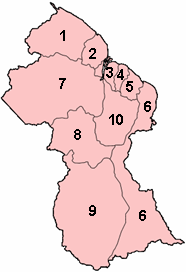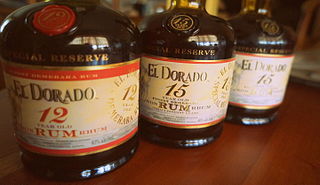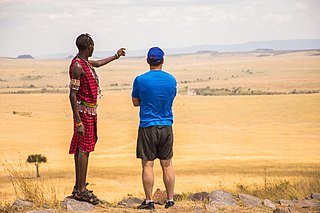Tourism in Guyana is a fledgling industry compared to other countries in the Caribbean. Tourism is mainly focused on ecotourism, and accommodations for business travelers. [1] Guyana is home to Kaieteur Falls, Mount Roraima, and St. George's Cathedral.
In 2020, 18 businesses and 12 tour guides were licensed with the Guyana Tourism Authority (GTA). [2]
Mark Ellwood, contributing editor for Conde Nast Traveler, has suggested thinking of Guyana "as a bonus Caribbean country" in terms of its cultural history even though it is physically part of South America. [3]
The primary draw for tourists from abroad is Guyana's Amazon Rainforest, considered one of the most pristine, untouched forests in the world. [4] Core markets are visitors from North America and the UK (also home to a large Guyanese diaspora) and some interest from markets like Germany and the Netherlands. [5] Guyana is South America's only English-speaking country. The GTA benchmarks its practices against the Green Destinations Standard, a Global Sustainable Tourism Council-recognized set of objective criteria for "measuring, monitoring and improving the sustainability policy in light of the growing interest in sustainable tourism". [6] Sustainable tourism is a key factor in hinterland development, offering economic diversity to the area, through Amerindian villages, such as lodges at Rewa and Surama, [7] and the Iwokrama International Centre for Rain Forest Conservation and Development. Tourism is seen as a way to provide employment in these remote communities, combatting the high migration rate out of these villages. [8]
Eco-tourism activities include birdwatching [9] [10] and catch and release fishing. [11]
Among many sites, Guyana is the home to Kaeitur Falls, the highest one drop waterfall in the world.
The oil industry, and its potential wealth boom, has encouraged development in the tourism industry, such as the building of a second Marriott Hotel slated for completion in 2023. [12] COVID-19 severely damaged the economies of the tourism-dependent Caribbean countries, but Guyana, like Trinidad and Tobago, continues to grow due to oil production. [13]
In 2018, tourism made up 0.58 percent of Guyana's GDP (world average: 7.87). [14]
| 1996 | 1998 | 2000 | 2002 | 2004 | 2006 | 2008 | 2010 | 2012 | 2014 | 2016 | 2018 |
|---|---|---|---|---|---|---|---|---|---|---|---|
| 92,000 | 66,000 | 105,000 | 104,000 | 122,000 | 113,000 | 130,000 | 152,000 | 177,000 | 206,000 | 235,000 | 287,000 |
After independence, Guyana's national policies were focused on self-reliance; President Forbes Burnham called the tourism industry "parasitic" and detrimental to social development, in contrast to its Caribbean neighbors. [16]
Infrastructure woes and perception of Guyana as a dangerous location damage tourism to and within the country. Recent focus has on improving safety standards, the visitor experience and enabling all tourism businesses to become licensed. [6]
Because of the diversity of Guyana, cultural events are an important source of tourism in the country. [17] Guyana Restaurant Week started in 2014 to attract new customers with reasonably-priced set menus. [18]

Ecotourism is a form of tourism marketed as "responsible" travel to natural areas, conserving the environment, and improving the well-being of the local people. The stated purpose may be to educate the traveler, to provide funds for ecological conservation, to directly benefit the economic development and political empowerment of local communities, or to foster respect for different cultures and human rights.

Guyana is divided into 10 regions:
Apoteri is a village in the Upper Takutu-Upper Essequibo Region of Guyana, near the confluence of the Rupununi River with the Essequibo, at an altitude of 53 metres. Apoteri started to develop as the centre of the balatá industry. The population is mainly Amerindian of the Macushi and Wapishana people.

Sustainable tourism is a concept that covers the complete tourism experience, including concern for economic, social, and environmental issues as well as attention to improving tourists' experiences and addressing the needs of host communities. Sustainable tourism should embrace concerns for environmental protection, social equity, and the quality of life, cultural diversity, and a dynamic, viable economy delivering jobs and prosperity for all. It has its roots in sustainable development and there can be some confusion as to what "sustainable tourism" means. There is now broad consensus that tourism should be sustainable. In fact, all forms of tourism have the potential to be sustainable if planned, developed and managed properly. Tourist development organizations are promoting sustainable tourism practices in order to mitigate negative effects caused by the growing impact of tourism, for example its environmental impacts.
Aishalton is an Amerindian village that is situated in the Rupununi savannah of southern Guyana, in the Upper Takutu-Upper Essequibo Region of the country.
The Iwokrama International Centre for Rain Forest Conservation and Development is an autonomous non-profit institution established by Guyana and the Commonwealth. It "exists to promote the conservation and the sustainable and equitable use of tropical rain forests in a manner that leads to lasting ecological, economic, and social benefits to the people of Guyana and to the world in general, by undertaking research, training, and the development and dissemination of technologies".

Demerara Distillers Ltd. is a Guyanese distillery known for the El Dorado Rum brand. It was at one time the world's second largest producer of rum.

Tourism in Kenya is Kenya's third largest source of foreign exchange revenue, following diaspora remittances and agriculture. The Kenya Tourism Board is responsible for maintaining information about tourism in Kenya.

Tourism in Costa Rica has been one of the fastest growing economic sectors of the country and by 1995 became the largest foreign exchange earner. Since 1999, tourism has earned more foreign exchange than bananas, pineapples and coffee exports combined. The tourism boom began in 1987, with the number of visitors up from 329,000 in 1988, through 1.03 million in 1999, over 2 million in 2008, to a historical record of 2.66 million foreign visitors in 2015. In 2012, tourism contributed with 12.5% of the country's GDP and it was responsible for 11.7% of direct and indirect employment. In 2009, tourism attracted 17% of foreign direct investment inflows, and 13% in average between 2000 and 2009. In 2010, the tourism industry was responsible for 21.2% of foreign exchange generated by all exports. According to a 2007 report by ECLAC, tourism contributed to a reduction in poverty of 3% in the country.
Peanut production in Guyana plays an important role in some areas of the country. In the remote Rupununi region of Guyana, peanut farming dominates the local economy and farmers depend upon the crop as their main source of income. Recent agricultural developments have enhanced production from 1,100 pounds per acre to over 2,500 in four years. As a result of increasing yields Guyanese farmers have not only benefited from local markets in Guyana but have increasingly seen the export of Guyanese peanuts in the Caribbean market.
The Burro-Burro River is a river of Guyana.
Wowetta is an indigenous village in the Upper Takutu-Upper Essequibo Region in Guyana. The village is mainly inhabited by Macushi people.
Surama is an Amerindian village in the North Rupununi area and the Upper Takutu-Upper Essequibo Region of Guyana, with a population of 274 people as of 2012.
Fairview (Kurupukari) is an indigenous settlement on the Essequibo River, in the Upper Demerara-Berbice region of Guyana. It is the entry point to the Iwokrama Forest. Former president David A. Granger once referred to Iwokrama as the "green heart of Guyana."

Mohamed Irfaan Ali is a Guyanese politician serving as the tenth and current president of Guyana since 2020. A member of the People's Progressive Party/Civic (PPP/C), he previously served as the minister of Housing and Water from 2009 to 2015. He is the first Muslim to hold office, and is the third Muslim head of state in the Americas after Noor Hassanali of Trinidad and Tobago and Carlos Saul Menem of Argentina.

Sydney Charles Allicock is a Guyanese politician. He was minister of Indigenous People's Affairs in Guyana from 2015-2020, and was vice-president of Guyana from 2015-2020.
Rewa is an Amerindian village in the Upper Takutu-Upper Essequibo region of Guyana.

Yupukari is an indigenous village of Macushi and Wapishana Amerindians in the Upper Takutu-Upper Essequibo Region of Guyana. It is located between the Kanuku and Pakaraima Mountains along the Rupununi River.
The Carnegie School of Home Economics (CSHE) is a service-sector trade school in Guyana.

Gondwana Ecotours is an American sustainable travel company specializing in small group and private escorted tours to different destinations worlwide. Founded by Jared Sternberg in 2013, it is headquartered in Homer, Alaska and offers itineraries in five different countries across three continents. Each tour focuses on highlighting the destination’s nature, wildlife, and culture.
{{cite web}}: |last= has generic name (help){{cite web}}: |first2= has generic name (help)CS1 maint: numeric names: authors list (link)